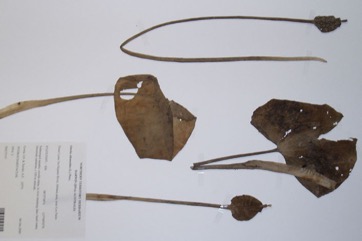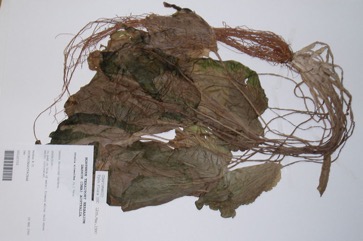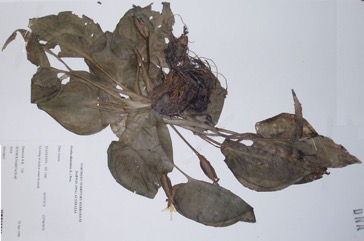Pond Lettuce

It is a tropical and subtropical plant. It can grow in stagnant water. It grows in wetlands. It occurs throughout the Philippines in shallow lakes and slow running streams. It needs bright light and warm water. In Yunnan. In Calicut Uni BG.
Also known as:
Chowehan, Dragon's tongue herb, Duck lettuce, Echeng, Kalabua, Keladi ayer, Khar, Mizu-obako, Panicola, Panikela, Panikola, Panikundri, Phak hob hep, Santawaa phak, Santawah pak, Senguntepa, Shui-che-chien, Shui jie cai, Shyamkola, Slab chrawa, Tarabang
Synonyms
- Damasonium alismoides (L.) R. Brown
- Damasonium indicum Willd.
- Ottelia condorensis Gagnep.
- Ottelia japonica Miquel
- Ottelia javanica Miquel
- Stratios alismoides L.
Edible Portion
- Leaves as condiment, Spice, Fruit, Flower stalks, Flowers, Seeds, Stems - tea
Where does Pond Lettuce grow?
Found in: Africa, Asia, Australia, Bangladesh, Cambodia, Central America, China, East Timor, Egypt, Europe, Guatemala, Himalayas, India, Indochina, Indonesia, Italy, Japan, Korea, Laos, Malaysia, Myanmar, Nepal, North Africa, North America, Northeastern India, Pacific, Pakistan, Papua New Guinea, PNG, Philippines, SE Asia, Solomon Islands, Sri Lanka, Thailand, Timor-Leste, United States, Vietnam
Notes: There are about 21-40 Ottelia species. They grow in the tropics. There is one species in tropical America.
Status: The leaves, stalks, and flowers have an attractive flavour. The ripe fruit are eaten especially by children. It is sold in local markets in China. It is cultivated.
Growing Pond Lettuce
Cultivation: Plants can be grown from seed. They are planted on mud or in shallow, warm water. It can also be grown by removing suckers.
Edible Uses: The mature fruit are eaten raw. They are also eaten cooked. The leaves and leaf stalks are eaten after cooking. They are also eaten raw with fish sauce. They are blanched. The flower buds are used as a vegetable.
Production: In northeastern India plants flower and fruit from September to March.
Nutrition Info
per 100g edible portion| Edible Part | Energy (kcal) | Protein (g) | Iron (mg) | Vitamin A (ug) | Vitamin c (mg) | Zinc (mg) | % Water |
|---|---|---|---|---|---|---|---|
| - | - | - | - | - | - |
Pond Lettuce Photos



References
Ambasta, S.P. (Ed.), 2000, The Useful Plants of India. CSIR India. p 417
Anderson, E. F., 1993, Plants and people of the Golden Triangle. Dioscorides Press. p 217
Baishya, S. Kr., et al, 2013, Survey of Wild Edible Fruits of Dhubri District, Assam, India. Plant Archives Vol 13 (1): 155-158
BARC, 2016, State of Biodiversity for Food and Agriculture in Bangladesh. Bangladesh Agricultural Research Council.
Baro, D., Baruah, S. and Borthukar, S. K. 2015, Documentation on wild vegetables of Baksa district, BTAD (Assam). Scholars Research Library. Archives of Applied Science Research, 2015, 7 (9):19-27
Brahma, S., et al, 2013, Wild edible fruits of Kokrajhar district of Assam, North-East India, Asian Journal of Plant Science and Research 3(6):95-100
Brown, W.H., 1920, Wild Food Plants of the Philippines. Bureau of Forestry Bulletin No. 21 Manila. p 24
Burkill, I.H., 1966, A Dictionary of the Economic Products of the Malay Peninsula. Ministry of Agriculture and Cooperatives, Kuala Lumpur, Malaysia. Vol 2 (I-Z) p 1641
Chowdery, T., et al, 2014, Wild edible plants of Uttar Dinajpur District, West Bengal. Life Science Leaflets. 47:pp 20-36 http://lifesciencesleaflets.ning.com
Chowdhury, M. & Mukherjee, R., 2012, Wild Edible Plants Consumed by Local Communities of Maldah of West Bengal, India. Indian J.Sci.Res.3(2) : 163-170
Cowie, I, 2006, A Survey of Flora and vegetation of the proposed Jaco-Tutuala-Lore National Park. Timor-Lests (East Timor) www.territorystories.nt/gov.au p 48
Cribb, A.B. & J.W., 1976, Wild Food in Australia, Fontana. p 136
Cruz-Garcia, G. S., & Price, L. L., 2011, Ethnobotanical investigation of 'wild' food plants used by rice farmers in Kalasin, Northeast Thailand. Journal of Ethnobiology and Ethnomedicine 7:33
Deka, N. & Devi, N., 2015, Wild edible aquatic and marshland angiosperms of Baka district, BTC area, Assam, India. Asian J. Plant Sci. Res. 5(1):32-48
den Hartog, C., 1957, Hydrocharitaceae in Flora Malesiana 5(4) p 398
Eiadthong, W., et al, 2010, Management of the Emerald Triangle Protected Forests Complex. Botanical Consultant Technical Report. p 51
Elliot, W.R., & Jones, D.L., 1997, Encyclopedia of Australian Plants suitable for cultivation. Vol 7. Lothian. p 123
Flora of Pakistan. www.eFloras.org
Hossain, U. & Rahman, A., 2018, Study and quantitative analysis of wild vegetable floral diversity available in Barisal district, Bangladesh. Asian J. Med. Biol. Res. 2018, 4 (4), 362-371
Hu, Shiu-ying, 2005, Food Plants of China. The Chinese University Press. p 283
Jacquat, C., 1990, Plants from the Markets of Thailand. D.K. Book House p 101
Japanese International Research Centre for Agricultural Science www.jircas.affrc.go.jp/project/value_addition/Vegetables
Johnson, N., 2002, Environmental Change in northern Thailand: Impact on Wild Edible Plant Availability. Ecology of Food and Nutrition, 41: 5, 373-399
Kachenchart, B., et al, 2008, Phenology of Edible Plants at Sakaerat Forest. In Proceedings of the FORTROP II: Tropical Forestry Change in a Changing World. Bangkok, Thailand.
Kumar, S. A., Manus, D. & Mallika, M., 2018, Impact of non-timber forest products on Forest and in Livelihood Economy of the People of Adjoining Areas of Jalpaiguri Forest Division, West Bengal, India. Int. J. of Life Sciences, 2018; 6 (2):365-385
Lazarides, M. & Hince, B., 1993, Handbook of Economic Plants of Australia, CSIRO. p 177
Leach, G.J., & Osborne, P.L., 1985, Freshwater Plants of Papua New Guinea. UPNG Press, p 157
Li, D. et al, 2017, Ethnobotanical survey of herbal tea plants from the traditional markets in Chaoshan, China. Journal of Ethnopharmacology. 205 (2017) 195-206
Liu, Yi-tao, & Long, Chun-Lin, 2002, Studies on Edible Flowers Consumed by Ethnic Groups in Yunnan. Acta Botanica Yunnanica. 24(1):41-56
Martin, F.W. & Ruberte, R.M., 1979, Edible Leaves of the Tropics. Antillian College Press, Mayaguez, Puerto Rico. p 99, 195
Menisa, A. A., et al, 2012, Survey and characterization of Indigenous Food Plants in Ilocos Norte, Philippines. SEARCA Discussion Paper series No. 2011-2
Mishra, N., et al, 2016, Indigenous knowledge in utilization of wetland plants in Bhadrak district, Odisha, India. Indian Journal of Natural Products and Resources. Vol. 7(1) pp. 82-89
Monsalud, M.R., Tongacan, A.L., Lopez, F.R., & Lagrimas, M.Q., 1966, Edible Wild Plants in Philippine Forests. Philippine Journal of Science. p 482 (As Otellia alismoides)
Pagag, K. & Borthakur, S.K., 2012, Wild edible wetland plants from Lakhimpur district of Assam, India. Pleione 6(2): 322 - 327
Pasha, M. K. & Uddin, S. B., 2019, Minor Edible Fruits of Bangladesh. Bangladesh J. Plant Taxon. 26(2): 299–313
Patiri, B. & Borah, A., 2007, Wild Edible Plants of Assam. Geethaki Publishers. p 140
Phon, P., 2000, Plants used in Cambodia. © Pauline Dy Phon, Phnom Penh, Cambodia. p 482
PROSEA handbook Volume 13 Spices. p 278
Reis, S. V. and Lipp, F. L., 1982, New Plant Sources for Drugs and Foods from the New York Botanical Garden herbarium. Harvard. p 9
Romanowski, N., 2007, Edible Water Gardens. Hyland House. p 112
Sainty, G.R. & Jacobs, S.W.L., 1981, Waterplants of New South Wales. Water Resources Commission. NSW p 247
Sainty, G., and Jacobs, S., 2003, Waterplants in Australia. A Field Guide. Sainty Books. p
Singh, H.B., Arora R.K.,1978, Wild edible Plants of India. Indian Council of Agricultural Research, New Delhi. p 32
Slocum, P.D. & Robinson, P., 1999, Water Gardening. Water Lilies and Lotuses. Timber Press. p 85
Srichaiwong, P., et al, 2014, A Study of the Biodiversity of Natural Food Production to Support Community Upstream of Chi Basin, Thailand. Asian Social Science 10 (2):
Stephens, K.M., & Dowling, R.M., 2002, Wetland Plants of Queensland. A field guide. CSIRO p 36
Swapna, M. M. et al, 2011, A review on the medicinal and edible aspects of aquatic and wetland plants of India. J. Med. Plants Res. 5 (33) pp. 7163-7176
Syn. pl. 1:400. 1805
World Checklist of Useful Plant Species 2020. Royal Botanic Gardens, Kew
Zhang, Y., et al, 2014, Diversity of wetland plants used traditionally in China: a literature review. Journal of Ethnobiology and Ethnomedicine. 10:72